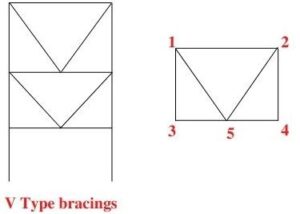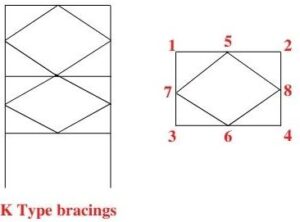Contents
What are bracings? Different types of bracing systems in building design?
Bracing systems are frequently used in designing of earth quack resistant structures. The bracings are the steel members which are connected to the corners of the bay frame for each storey of the building structure. Bracing systems will helps to decrease the deflection and storey drift values under the action of the lateral loading condition namely seismic load and wind load. In this article you can able to find bracings and types of bracings used in building construction concepts.
In simple words for example let us consider a building which is need to build in zone V seismic condition which is having seismic coefficient factor Z is 0.36. In that particular conditions the values of the deflection, and storey drift will be more to reduce the intensities of values design of earth quake resistant structure concepts are followed. The bracing systems are now a day’s most popularly using earth quake resistant method than remaining namely shear walls, dampers, infill walls and base isolations etc.
Type of bracing systems used in building design
Depending upon the various requirements in building systems the major bracings are classified in to six following types
- Forward bracings
- Backward bracings
- V type bracings
- Inverted V type bracings
- X type bracings and
- K type bracings
Forward bracing systems
The forward bracing systems are comes under the diagonal bracings type, in this the bracing system is connected in the diagonal direction to the end points. See the forward bracing system model in the below specified figure which is consisting of four end points namely 1, 2, 3 and 4. The steel bracing system is joined from the 1st end to the 4th end point. The forward bracing system under the category of diagonal type is generally helps to reduce the X direction or Y direction storey drift values under the lateral loading actions (wind load and seismic load values).

Backward bracing systems
The backwards bracing system is the second type which is comes under the diagonal bracings. The basic concept is similar to that of the forward bracing system but the storey drift value is decreases in the opposite direction of forward bracings. See the complete backward bracings type in the below figure which is again consisting of four end points for the bay frame. The bracing system is connected to the 2nd and 3rd end points. This type of bracings system is helps in decreasing the storey drift values in –X direction or –Y direction to the building structure under the lateral loading action.

V type bracing system
The V type bracing system is comes under third type which is comes under the vertical bracings system. The main objective of this case is to control the vertical deflection. The bracing is connected in three points one is at the one end corner, second one is at the other end corner and third point is at the center of the opposite side. The assignment of V type bracing model is shown in the below figure it contains the five points namely 1, 2, 3, 4 and 5. The connection of bracings is made from the points 1, 5 and finally to 2. By providing the V type bracing system for the building the vertical deflection value through the height direction decreases to make earth quake resistant buildings.

Inverted V type bracing system
Inverted V type bracing system is having similar type of alignment and installation as per the V type bracings standards. In this type also the connection for the bare frame is made with 5 points connection. The complete inverted V type bracing system layout is shown in the below figure which is consisting of same 5 points namely 1, 2, 3, 4 and 5. The proper connection of steel bracing system was made through the alignment of points 3, 5 and 4. The major advantage is to reduce the vertical deflection value for the building structures for this inverted V type bracing system case.

X type bracing system
The X type bracing system is the most commonly used type for the deflection and drift controlling. In this type the bracings are connected to the each corner point of the bare frame in the X type shape. The complete bracing system model is shown in the below figure which is consisting of four corners namely 1, 2, 3 and 4. The bracings are connected in two diagonal directions through the points of 1 and 4, 2 and 3. With the help of the four joint connections at the each corner the building will be in stable condition structure will not move in X direction system and it will note move in Y direction system under the application of the lateral loading conditions like seismic loading condition and wind load condition and simultaneously it will not move in the deflection direction (height direction).

K type bracing system
K type bracing systems are comes under the final type. In this case of bracing system the bracings ends are connected to the center point of the bare frame. The complete K type bracing model is shown in the below figure which is consisting of points 1, 2, 3, 4,5, 6, 7 and 8. The bracing model is connected with the 5, 8 and 6 in the right hand section of the bare frame and 5, 7 and 6 in the left hand section of the bare frame. Due to the presents of the center point of the bare frame connection for the bracing systems the additional stability increases in the building model as per the earth quake resistant building designs. With the help of the additional stiffness the value of the deflection in both X direction and Y direction in positive and negative directions decreases.
Similarly the value of the vertical deflection in the building structure decreases under the lateral loading condition system application like earth quake and wind load conditions as per the IS 1893 code standards in earth quake and IS 875 code for the wind load standards.

Follow our previous posts here
Design requirements of RCC slab as per the standards
Basic rules in foundation design as per the standards
Which cement is best OPC cement or PPC cement in building construction?
What is wind terrain category and different type terrain category as per standards?
Foundation design for G+2 building as per IS code
Complete building detailing as per ETABS software
Conclusions of what is bracings and different types of bracing systems used in building construction
Well now the explained concepts are related to the bracing systems and types of bracings used in the building design. The major bracing systems are classified in to six types. Namely forward bracings, backward bracings, V type bracings, inverted V bracings, X type bracing systems and K type bracing systems. Depending upon the various requirements of decreasing the deflection and storey drift values bracing systems are utilized.
For more interesting updates on civil engineering concepts follow my YouTube channel Civil engineering by shravan.
If you have any quarries regarding this article fell free to reach us through contact us page.
Thank You,
Your Shravan,
Have a good day.